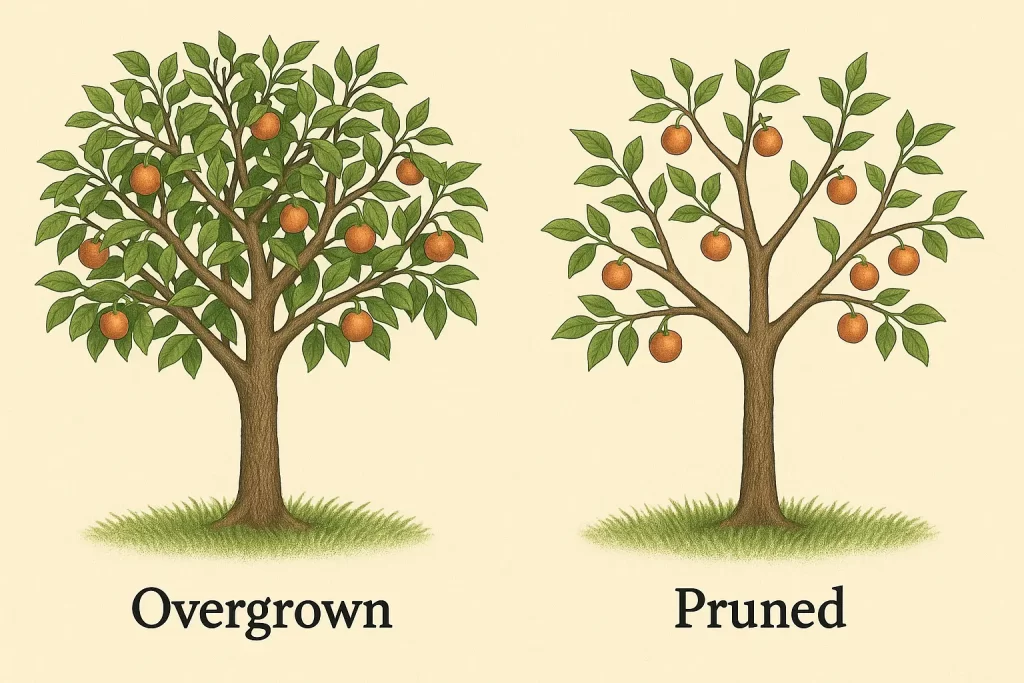How to Trim Fruit Trees – Tips from a Tree Health Expert
- Alicia
As a Plant Health Care Specialist with years of hands-on experience, I have seen firsthand how proper pruning can rejuvenate a fruit tree and keep it productive for years to come. If you are a beginner or a home gardener hoping to care for your trees with confidence, this guide is for you.
In a recent post, our Certified Arborist, John, shared helpful techniques for trimming landscape trees, focusing on structure, shape, and tree health. Building on those insights, I will now walk you through the steps I follow when trimming fruit trees. From apples and figs to lemons and Olives, you will learn how to prune for better airflow, more sunlight, and a stronger, healthier harvest.

Why Prune Fruit Trees?
Pruning a fruit tree is one of the most important decisions you will make in its care.
When done correctly, pruning increases airflow, improves sunlight penetration, encourages productive growth, and prevents diseases like powdery mildew or fire blight. I have worked on many overgrown backyard trees that produced small or no fruit. Once we removed the dead, crossing, or unproductive branches, these trees began to grow with balance and strength. Within a single season, they produced better quality fruit with fewer pest issues.
Expert Tip
Opening up the canopy helps sunlight reach every branch, which can make a big difference in how your fruit grows.
You are not just removing branches; you are guiding energy into strong limbs that will support healthy, fruit-bearing wood. Without pruning, fruit trees often become congested with weak, crisscrossing branches and old wood. These shaded areas with poor airflow create an ideal environment for pests and disease to spread.

When to Prune Fruit Trees
We already discussed seasonal timing in a previous post that outlines when different types of trees should be pruned based on climate and growth cycles. That guide offers a helpful breakdown for planning your pruning schedule year-round.
As for fruit trees specifically, most should be pruned in late winter to early spring while they are dormant. This timing allows the tree to recover quickly once new growth begins. For example, citrus trees are best pruned after the last frost.
Pruning while the tree is dormant also gives you a clear view of its structure, making it easier to shape the canopy and remove dead or unproductive wood without disrupting fruit development.
Dormant Period = Best Time
Fruit Tree Pruning Calendar by Region
Now that you know the best time to prune each fruit tree from the calendar, let’s walk through how to do it right to keep your trees healthy and productive.
General Steps for Pruning Fruit Trees
Step 1: Sanitize Your Tools
Always start with clean, sharp tools. I disinfect my pruners and loppers with a 10% bleach solution or rubbing alcohol to prevent spreading diseases between trees.
Step 2: Identify Dead, Diseased, or Damaged Wood (the 3 D’s)
Remove any branches that are lifeless, broken, or infected. This improves the overall health and reduces the risk of pest problems.
Step 3: Remove Suckers and Water Sprouts
Suckers shoot up from the base or roots, while water sprouts grow vertically from main branches. Both should be pruned because they sap energy and rarely produce fruit.
Step 4: Thin the Canopy
Your goal is to allow light and air to reach the center of the tree. Remove any branches that cross or crowd others. I often follow a modified open center or central leader structure, depending on the species.
Step 5: Make Clean, Correct Cuts
Always cut just above a healthy bud or lateral branch, angling slightly away from the bud. For thicker limbs, use the 3-cut method to avoid tearing bark.
Want to See These Steps in Action?
Download our free step-by-step visual guide to learn how to prune fruit trees the right way, with helpful diagrams and clear illustrations.
📥 Download the Pruning GuideHow to Trim Specific Fruit Trees
🍎 How to Trim an Apple Tree
Apple trees benefit from a central leader structure. I remove any vertical water sprouts and focus on horizontal branches spaced evenly around the trunk. Ideally, each scaffold branch should get full sun. Older apple trees need heavier thinning to stimulate new fruit-bearing wood.
🍈 How to Trim a Fig Tree
For figs, I usually go with an open vase shape. This involves cutting back to three to five main branches and keeping the center clear. I also remove interior shoots that block airflow. Prune figs in late winter and keep cuts minimal if the tree is young.
🍋 How to Trim a Lemon Tree
Lemon trees do not like heavy pruning. I focus on shaping and removing only the dead or weak growth. Branches that rub against each other are trimmed back to improve airflow. Be cautious, especially with mature citrus; pruning too hard can reduce flowering.
🫒 How to Trim an Olive Tree
Olives also benefit from an open center shape. I start by selecting 3–4 strong lateral branches and removing upright growth. Keeping the center open allows better light penetration. Young olive trees can handle a heavier initial prune, while older ones need more careful thinning.
🍑 How to Trim a Peach Tree
Peach trees thrive with an open center or vase shape. After planting, I cut back the tree to about 30 inches high to encourage strong lateral branches. Each year, I remove upright shoots, water sprouts, and any branches growing toward the center. Pruning is best done in late winter to early spring, just before bud swell.
🫐 How to Trim a Plum Tree
For plum trees, I prefer a modified central leader structure. I start by removing suckers, vertical water sprouts, and crossing limbs. Focus is on maintaining a balanced framework of scaffold branches. European plums need lighter pruning, while Japanese plums can handle more aggressive thinning. Early spring is the best time to prune.
Want general tips, tool recommendations, and common pruning mistakes to avoid?
Check out our complete guide to trimming trees — it covers all the basics you should know before grabbing your tools.
Still unsure about the right approach for your tree? Let our experts handle it. Request a quote or explore our tree trimming services to get started with confidence.
Final Words from a Tree Health Expert
Pruning may seem intimidating at first, but once you understand the purpose behind each cut, it becomes an incredibly rewarding part of fruit tree care.
“You are guiding the tree, not controlling it.”
With time and observation, you will develop an eye for what needs to go and what should stay. Remember: each tree is different, and there is no one-size-fits-all method. But the core principles remain the same, clean cuts, open structure, and attention to the tree’s natural shape.
Happy trimming!